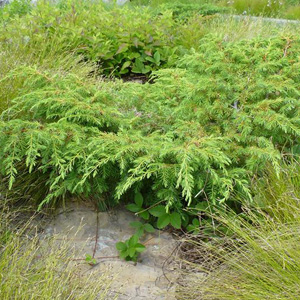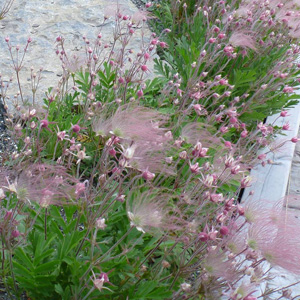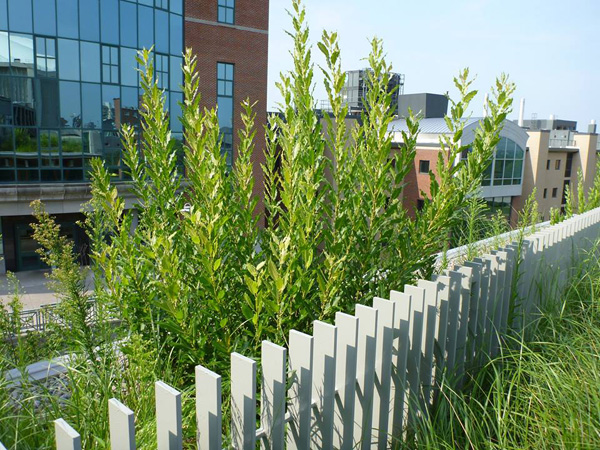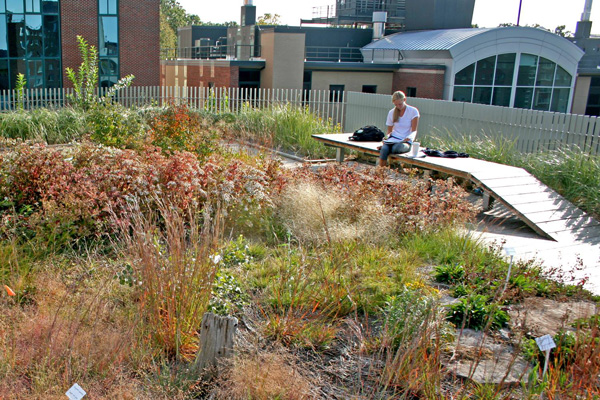Last summer I had the pleasure of touring the successful experiment that is the State University of New York College of Environmental Science and Forestry’s Gateway Center green roof, a beautiful and instructional rooftop garden inspired by native New York dune and barrens plant communities. This green roof is open to the public during regular business hours and is not to be missed if you find yourself in the vicinity of Syracuse.
A Roof with a Mission
Their campuses are adjacent, but their landscaping approaches are strikingly different. While Syracuse University uses a more conventional palette of plant hybrids and non-natives (for example, widespread use of orange petunias to celebrate the school color), SUNY ESF strives to follow a native-plant-community approach to their landscaping (using, for example, native goldenrods, oaks, sumacs, and sedges).
Thus it made sense that in 2010, when it came time to design a new 9,400-square-foot green roof, SUNY ESF wanted to use the opportunity to use plant species found in natural New York plant communities. From the common to the very rare, plants within those communities provide a richer research and teaching environment than could be afforded by the seas of sedums and other succulents that usually dominate green roofs.
This green roof is a versatile outdoor classroom and gathering place atop SUNY ESF’s award-winning new LEED Platinum Certified Gateway Center Building (completed in 2013). The green roof was designed to contribute to the Gateway Center’s highly efficient storm water management system and to aid in regulating building temperature.
Rugged for the Rooftop
The lead landscape architect for the project was Darren Damone of the Philadelphia-based firm Andropogon Associates. In order to determine the best plant species for the roof, Damone and his associates worked closely with faculty at SUNY-ESF, including Distinguished Teaching Professor of Environmental and Forest Biology Don Leopold (author of Native Plants of the Northeast: A Guide for Gardening and Conservation and Trees of New York: Native and Naturalized) and Associate Professor of Landscape Architecture Timothy Toland, who specializes in sustainability and holistic systems design.
In thinking about the conditions that are typical for a rooftop garden, and in their case a west-facing one, the Andropogon/SUNY ESF team recognized that they needed plants that would endure extremes of temperature, wind, and moisture. To minimize future maintenance, they sought plants that can tolerate low soil fertility/low organic matter and shallow soils. Drought tolerance was also key, as the intent was to have the plants function as they would in their native environment—without any supplemental irrigation.
The team chose two natural New York plant communities adapted to these very conditions. The first was the Eastern Ontario Dune community, a windy and dry habitat extending 17 miles along Lake Ontario. As you can imagine, the dune soil is low in fertility, drains excessively well, and is exposed to potential erosion by wind and water.
The second inspiration was the Alvar Pavement Barren community, found in limited pockets to the northwest of Watertown, NY. Alvars are harder to describe than dunes. They consist of some combination of rocky outcroppings, flat stretches of exposed limestone bedrock, deep crevices, and moss growing amidst rubble. These can be mingled with parcels of woodlands, grasslands, and shrubby meadows that are supported by only a thin layer of soil. Alvars are home to many rare plants. Alvar community plants grow in low-fertility soil with a high pH and despite the shallow soils they inhabit (or lack of soil altogether), they tolerate the drought of summer—but interestingly, they also tolerate spring flooding.
With the Eastern Ontario Dune and Alvar Pavement Barren communities, the team found an ideal match for the rooftop conditions. Their savvy matching of plants—in this case, whole communities of plants—to site is something that could be instructive to home gardeners who have extreme conditions on parts of their properties.
It would be no small feat to source these plants—some of which grow natively only in the Eastern Ontario Dune and Alvar Pavement Barren ecosystems—responsibly. Motherplants Ltd., a green roof plants specialty grower now based out of Princeton, Ontario (formerly based out of Ithaca) was contracted to propagate and procure the plants.
But first, the design team and SUNY ESF faculty developed a set of rigorous plant trial protocols and constructed a series of test frames on an adjacent building roof to mimic growing conditions.
In 2010, Leopold and colleagues obtained cuttings, seeds, and plugs and involved students in research involving planting each species at varying soil depth, media, and spacing. They collected three seasons of data, which gave evidence that plants from these specific plant communities did well in this specific unirrigated, rooftop environment.
The Andropogon Associates planting plan called for the Eastern Ontario Dune plant community to be sited on three sides of the green roof perimeter. Dune plants that are thriving there include American beach grass (Ammophila breviligulata), Canada wild rye (Elymus canadensis), and the heartleaf willow (Salix cordata).
The internal, slightly more protected beds are populated primarily with Alvar community plants, which include American harebell (Campanula rotundifolia), hairy beardtongue (Penstemon hirsutus), northern prairie dropseed (Sporobolus heterolepis), smooth rose (Rosa blanda), and various sedges (Carex spp.).

Don Leopold took this photo of the native American harebell (Campanula rotundifolia), which grows in many parts of New York State in rocky areas, be they dry or wet, calcareous or acidic. “This plant grows on alvar pavement barrens and is among many state-protected plant species on the Gateway green roof,” he says.

Don Leopold says, “Found on the Gateway green roof, the common juniper (Juniperus communis) is well-named as one of the most geographically widespread and highly adaptable woody plant species in the world. It is abundant on the Great Lakes alvar, where its form is typically a low, spreading shrub. Elsewhere, this species can be an upright, pyramidal small tree.” Photo by Don Leopold

Don Leopold says that if you visit the Gateway green roof in mid-April, you may be treated to a sight unusual in New York: blooming prairie-smoke (Geum triflorum). It is a very rare plant in NYS, limited to Jefferson and Dutchess Counties. “Despite its rarity, it is thriving on the Gateway Center green roof and is the first of dozens of plant species on the roof to bloom each spring,” Leopold says. “Prairie-smoke can be easily cultivated in the home garden if given a well-drained, gravelly-sandy and infertile substrate in full sun.” Behind it you can see wild columbine (Aquilegia canadensis) and to the left is shrubby cinquefoil (Potentilla fruticosa). Photo by Don Leopold

According to Don Leopold, “Of the three varieties of sand cherry (Prunus pumila) that occur in New York, var. pumila is the rarest, being restricted to the narrow band of natural dunes along the shoreline of eastern Lake Ontario. It is an ‘S1 Heritage element,’ a state ranking applied to species that generally have between 1 to 5 occurrences in the state. You will find it within the ‘dunes’ perimeter planting of the Gateway green roof.” Photo by Don Leopold

According to Don Leopold, “The sand dune willow (Salix cordata) is a rare upland shrubby willow restricted in New York State to the narrow band of natural dunes along less than 20 miles of the shoreline of eastern Lake Ontario. It is an ‘S2 Heritage element,’ a state ranking applied to species that generally have 6 to 20 occurrences in the state. Because it thrives on the coarse, dry sands of these dunes, it was chosen as one of the main plants to represent the dunes on the Gateway green roof, planted on the perimeter bed. Given how well it has done there, and in our other plantings on even more challenging substrates, this species likely could have much broader use in the landscape where few other species readily grow.” Photo by Don Leopold
Project Fruition
Motherplants brought in 3000 plugs in November of 2012, the earliest the roof could be readied for planting. Mark Winterer, co-owner of Recover Green Roofs, who collaborated on the planting, said, “We had to wait for the ground to thaw every morning before we could plant.” However, planting the plugs in a dormant state turned out to have an advantage—their moisture requirements were low, and with supplemental water provided for just the first few weeks after planting, the vast majority of the plants came through the winter and established well.
A highly porous, lightweight growing medium was conveyed to the site by a blower truck; it was intended to have less than 10% by mass organic matter (OM), because overly fertile soil would favor the growth of certain species over others, which would have upset the plant-community balance the designers sought. (Based on observing overly vigorous growth of some plants, Leopold later commented that 5% or less OM would have worked better.)
The earth was sculpted with sections of expanded polystyrene geofoam to provide some undulations for aesthetic and microclimate purposes. Jute erosion control mat, while difficult to install on a windy roof top in November, turned out to be extremely important in stabilizing the friable growing medium against erosion. Irregular flagstone slabs mimicked the exposed limestone bedrock found in an alvar environment and provide entry points for teachers, students, and visitors to gain a closer look at the plants.
Nearly four years after installation, the green roof plant communities are thriving and the beautiful outdoor gathering, teaching, and research space is fulfilling its mission. Leopold said recently, “Given that we are not aware of any similar planting on any other green roof in the U.S., I have been very pleased that the plant species that we selected have generally thrived under these very challenging growing conditions.”
SUNY ESF and Andropogon Associates received the 2014 Merit Award from the New York Chapter of the American Society of Landscape Architects for the Gateway Center green roof.
Michelle Sutton (michellejudysutton.com) is a horticulturist, writer, and editor.
Views: 14









